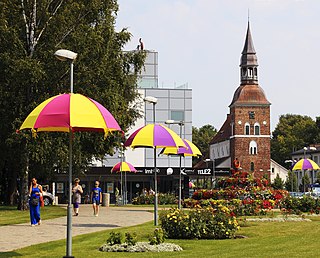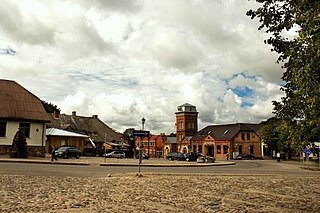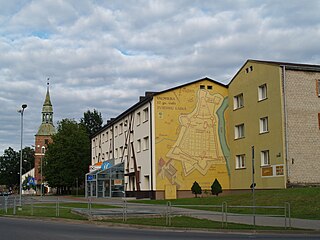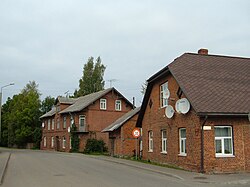
Valmiera is the second largest city of the historical Vidzeme region, Latvia, with a total area of 19.35 square kilometres. As of 2002, Valmiera had a population of 27,323, and in 2020, it was at 24,879. It is a state city, and is the seat of the Valmiera Municipality. Valmiera is one of the oldest cities in Latvia; it was a member of the Hanseatic League. According to the ethnic composition, Valmiera has the largest proportion of ethnic Latvians among the state cities.

Madona is a town with town rights in the Vidzeme region of Latvia and is the center of the Madona municipality.

Historical Latvian Lands or formerly Cultural regions of Latvia are several areas within Latvia formally recognised as distinct from the rest of the country. These are: Kurzeme (Courland), Zemgale (Semigallia), Latgale (Latgalia), Vidzeme, and Sēlija (Selonia). While some of these regions are seen purely as culturally distinct, others have historically been parts of different countries and have been used to divide the country for administrative and other purposes.

Limbaži is a town in the Vidzeme region of northern Latvia, with a population of 6,888. Limbaži is located 90 km northeast of the capital Riga. During the Middle Ages, as part of Livonia, Limbaži was a fortified town with stone walls, second in importance only to Riga.

The Salaca is a river in northern Latvia. It flows from Lake Burtnieks in Vidzeme, 90 km, to the Gulf of Riga. The river flows through three towns, Mazsalaca, Staicele and Salacgrīva. The riverbanks feature Devonian red sandstone cliffs, and many caves and rapids as well. The river gives its name to a dialect of Livonian spoken on its upper banks into the 19th century, which is today extinct.

Vidzeme is one of the Historical Latvian Lands. The capital of Latvia, Riga, is situated in the southwestern part of the region. Literally meaning "the Middle Land", it is situated in north-central Latvia north of the Daugava River. Sometimes in German, it was also known as Livland, the German form from Latin Livonia, though it comprises only a small part of Medieval Livonia and about half of Swedish Livonia. Most of the region's inhabitants are Latvians (85%), thus Vidzeme is the most ethnically Latvian region in the country.

Ainaži is a Latvian port town by the Gulf of Riga in the Baltic Sea. Administratively, it is part of the Limbaži Municipality in the Vidzeme region of Latvia. It is located on the south side of the Estonia-Latvia international border, on the site of an ancient Livonian fishing village.

Saulkrasti is a town in Latvia on the east coast of the Gulf of Riga and the capital of the Saulkrasti municipality. Made up of a number of historic fishing settlements, the town stretches for some 17 km from the Inčupe river in the south to the village of Skulte in the north. The town itself spans across 4.8 square kilometres (1.9 sq mi) and includes an additional 42 square kilometres (16 sq mi) of fields and forests.

Smiltene is a town in the Vidzeme region in northern Latvia, 132 km northeast of the capital Riga, and the administrative centre of Smiltene Municipality. It has a population of 5,536 (2015).

The North Vidzeme Biosphere Reserve(NVBR) (Latvian: Ziemeļvidzemes biosfēras rezervāts) is the only biosphere reserve in Latvia, located in the northern Vidzeme region in north-western Latvia along the border with Estonia. The reserve includes varied natural and semi-natural habitats in primal and traditional landscapes. NVBR includes 25 nature reserves, one nature park and two marine protected territories.

Positivus Festival is an annual, three-day summer music and culture festival that was held in Salacgrīva, Latvia from 2007 to 2019. After two cancelled editions due to the COVID-19 pandemic, the festival moved to the capital city of Riga from 2022.

The A1 highway (Riga - Border of Estonia ), also known as the Tallinn highway is a national road in Latvia, which connects the Riga bypass with the Estonian border at Ainaži. The highway continues in Estonia as highway 4 until Tallinn. A1 is fully covered in asphalt, and its length in Latvia is 101,7 km. The highway is part of European route E67 and, starting from Lilaste until the Estonian border, does not move further than 6 km from the coast of the Baltic Sea.

Liepupe Parish is one of the administrative units of Limbaži Municipality in Latvia. From 2009 to 2021, Liepupe Parish was part of the former Salacgrīva Municipality and before 2009, it was part of the former Limbazi District. The administrative center is the village of Mustkalni. Latvian law defines Liepupe Parish as a part of the region of Vidzeme.

Aloja Municipality is a former municipality in Latvia. The municipality was formed in 2009 by merging Aloja town with its countryside territory, Staicele town with its countryside territory, Braslava Parish and Brīvzemnieki Parish, the administrative centre being Aloja. In 2010 Aloja Parish was created from the countryside territory of Aloja town and Staicele Parish was created from the countryside territory of Staicele town.

Limbaži Municipality is a municipality in Vidzeme, Latvia. The municipality was formed in 2009 by merging Katvari Parish, Limbaži Parish, Pāle Parish, Skulte Parish, Umurga Parish, Vidriži Parish, Viļķene Parish and Limbaži town, with the administrative centre being Limbaži.

Salacgrīva Municipality is a former municipality of Latvia. It was created as a result of the territorial reform in 2009, which united several former parts of Limbaži region - Salacgrīva town with its rural areas, Ainaži town with its rural territory and Liepupe Parish. Salacgrīva municipality is bordered by Aloja and Limbaži municipalities and Estonian Pärnu circuit. The centre of the municipality was Salacgrīva. The population in 2020 was 7,152.

Saulkrasti Municipality is a municipality in Vidzeme, Latvia. The municipality was formed in 2009 by reorganization of Saulkrasti town with its countryside territory, with the administrative centre being Saulkrasti. In 2010 Saulkrasti parish was created from the countryside territory of Saulkrasti town. The population in 2020 was 6,735.

Carnikava, previously Sānkaule, is a village and the center of Carnikava Parish in Ādaži Municipality, Latvia. It's located 25 km north from Riga at the mouth of the Gauja River. Carnikava had 4689 residents as of January 2020, making it the largest village by population in Latvia.

Latvijas Radio 5 - Pieci.lv is part of Latvijas Radio public service broadcasting network based in Riga, Latvia. Pieci.lv is public service broadcasting for youth, combining subculture, different lifestyle and opinion leaders. Currently the network consists of nine internet only stations and a nationwide FM station.

Valmiera Municipality is one of the 35 municipalities established in Latvia in 2021, located approximately 180 kilometres (110 mi) west of the national capital Riga. Its first elected municipal council took office on 1 July 2021. Its seat is the city of Valmiera.




























